alb5468155
China: Consort Rong, 'The Fragrant Concubine' (1734-1788), consort of the Qianlong Emperor. Painting by Lang Shining (Giuseppe Castiglione,1688-1766).

|
Añadir a otro lightbox |
|
Añadir a otro lightbox |



¿Ya tienes cuenta? Iniciar sesión
¿No tienes cuenta? Regístrate
Compra esta imagen.
Selecciona el uso:

Título:
China: Consort Rong, 'The Fragrant Concubine' (1734-1788), consort of the Qianlong Emperor. Painting by Lang Shining (Giuseppe Castiglione,1688-1766).
Descripción:
Ver traducción automática
The Fragrant Concubine (Chinese: Xiangfei; Uyghur: Iparxan, Khoja Iparhan) is a figure in Chinese legend who was taken as a consort by the Qianlong Emperor during the 18th century. Although the stories about her are believed to be mythical, they may have been based on an actual concubine from western China who entered the harem of the emperor in 1760 and who carried the court title of Rong Fei. Some suggest, however, that Imperial Consort Rong (whose original name may have been Maimur Azum) and Imperial Consort Xiang were different women. Han Chinese and Uyghur tellings of the legend of the Fragrant Concubine diverge greatly, and her experience represents a powerful symbol for both peoples. The story became greatly popular during the early 20th century and has since been adapted into several plays, films, and books.
Crédito:
Album / Pictures From History/Universal Images Group
Autorizaciones:
Modelo: No - Propiedad: No
¿Preguntas relacionadas con los derechos?
¿Preguntas relacionadas con los derechos?
Tamaño imagen:
3700 x 4928 px | 52.2 MB
Tamaño impresión:
31.3 x 41.7 cm | 12.3 x 16.4 in (300 dpi)
 Pinterest
Pinterest Twitter
Twitter Facebook
Facebook Copiar enlace
Copiar enlace Email
Email
